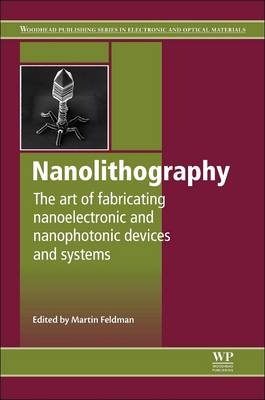
Nanolithography
Woodhead Publishing Ltd (Verlag)
978-0-08-101404-2 (ISBN)
- Titel wird leider nicht erscheinen
- Artikel merken
Nanolithography outlines the present state of the art in lithographic techniques, including optical projection in both deep and extreme ultraviolet, electron and ion beams, and imprinting. Special attention is paid to related issues, such as the resists used in lithography, the masks (or lack thereof), the metrology needed for nano-features, modeling, and the limitations caused by feature edge roughness. In addition emerging technologies are described, including the directed assembly of wafer features, nanostructures and devices, nano-photonics, and nano-fluidics.
This book is intended as a guide to the researcher new to this field, reading related journals or facing the complexities of a technical conference. Its goal is to give enough background information to enable such a researcher to understand, and appreciate, new developments in nanolithography, and to go on to make advances of his/her own.
Martin Feldman is a Professor of Electrical and Computer Engineering at Louisiana State University, USA.
Contributor contact details
Woodhead Publishing Series in Electronic and Optical Materials
Preface
1: Optical projection lithography
Abstract
1.1 Introduction
1.2 Lithography technology and trends
1.3 Fundamentals of optical lithography
1.4 Image evaluation
1.5 Projection lithography systems
1.6 Wavelengths for optical lithography
1.7 Lithography in the deep ultraviolet (UV)
1.8 Resolution enhancement technology
1.9 Immersion lithography
1.10 Multiple patterning optical lithography
1.11 Conclusion
2: Extreme ultraviolet (EUV) lithography
Abstract
2.1 Introduction
2.2 EUV sources
2.3 EUV optics
2.4 EUV masks
2.5 EUV resists
2.6 EUV integration and implementation challenges
2.7 Conclusion and future trends
2.8 Acknowledgments
3: Electron beam lithography
Abstract
3.1 Introduction
3.2 Using pixel parallelism to address the throughput bottleneck
3.3 The tradeoff between resolution and throughput
3.4 Distributed systems
3.5 Ultimate lithographic resolution
3.6 Electron-beam patterning of photomasks for optical lithography
3.7 Conclusion
3.8 Acknowledgements
4: Focused ion beams for nano-machining and imaging
Abstract
4.1 Introduction
4.2 An adumbrated history of focused ion beams (FIBs)
4.3 Sources of ions: a quartet of types
4.4 Charged particle optics
4.5 Ion-matter interactions
4.6 Milling
4.7 Deposition
4.8 Imaging
4.9 Spectroscopy
4.10 Conclusion and future trends
5: Masks for micro- and nanolithography
Abstract
5.1 Introduction
5.2 Mask materials
5.3 Mask process
5.4 Mask metrology
5.5 Defects and masks
5.6 Conclusion
6: Maskless photolithography
Abstract
6.1 Introduction
6.2 The use of photons as opposed to charged particles
6.3 Forms of maskless photolithography
6.4 Zone-plate-array lithography (ZPAL)
6.5 Proximity-effect correction
6.6 Extending the resolution of ZPAL
6.7 Commercialization of ZPAL by LumArray, Inc.
6.8 Conclusion
7: Chemistry and processing of resists for nanolithography
Abstract
7.1 Introduction
7.2 Resists for optical lithography: synthesis and radiation induced chemistry of resists as a function of exposure technology
7.3 Chemically amplified resist process considerations
7.4 Chemically amplified resists for 193 nm lithography
7.5 Resists for extreme ultraviolet lithography (EUVL)
7.6 Resists for electron beam lithography
7.7 Resists for selected forward looking lithographic technologies
7.8 Resist resolution limitations
7.9 Conclusion
8: Directed assembly nanolithography
Abstract
8.1 Introduction
8.2 Block copolymers in lithography
8.3 Directed self-assembly of block copolymers
8.4 Programmable three-dimensional lithography
8.5 Conclusion
9: Nanoimprint lithography
Abstract
9.1 Introduction
9.2 An overview of imprint lithography
9.3 Soft lithography
9.4 Thermal imprint lithography
9.5 Alternative thermal imprint processes
9.6 Ultraviolet (UV) nanoimprint lithography overview
9.7 Jet and flash imprint lithography
9.8 Roll to roll imprint lithography
9.9 Defectivity
9.10 Conclusions
9.11 Acknowledgments
10: Nanostructures: fabrication and applications
Abstract
10.1 Introduction
10.2 Characterization of nanostructures
10.3 Methods to create nanostructures: top-down fabrication of nanostructures
10.4 Methods to create nanostructures: bottom-up fabrication of nanostructures
10.5 Properties of nanostructures
10.6 Applications of nanostructures
11: Nanophotonics: devices for manipulating light at the nanoscale
Abstract
11.1 Introduction
11.2 Photonic crystals
11.3 Ring resonators
11.4 Extraordinary optical transmission through subwavelength apertures
11.5 Optical nanoantennas
11.6 Plasmonic focusing
11.7 Near-field optical microscopy
11.8 Plasmonic waveguides
11.9 Enhancement of nonlinear processes
11.10 Application in photovoltaics
11.11 Conclusion
12: Nanodevices: fabrication, prospects for low dimensional devices and applications
Abstract
12.1 Introduction
12.2 Motivation for nanodevices
12.3 Nanofabrication: creating the building blocks for devices
12.4 Prospects for low dimensional devices
12.5 Beyond the bottom-up: hybrid nanoelectronics
12.6 Conclusion and future trends
13: Microfluidics: technologies and applications
Abstract
13.1 Introduction
13.2 Current trends in microfluidics
13.3 Present state of technology
13.4 Applications
13.5 Future trends
13.6 Conclusion
13.7 Sources of further information and advice
14: Modeling of nanolithography processes
Abstract
14.1 Introduction
14.2 Optical lithography modeling
14.3 The optical system in optical lithography modeling
14.4 Photoresist model
14.5 Model critical dimension (CD) extraction
14.6 Difficulties in modeling
14.7 Extreme ultraviolet (EUV)/electron beam lithography modeling
14.8 Conclusion
15: Mask-substrate alignment via interferometric moire fringes
Abstract
15.1 Introduction
15.2 Background to alignment methods
15.3 Fundamentals of interferometric-spatial-phase imaging (ISPI)
15.4 Implementation of moire
15.5 Characteristics of moire fringe formation
15.6 Performance of ISPI
15.7 Backside ISPI
15.8 Conclusion and future trends
16: Sidewall roughness in nanolithography: origins, metrology and device effects
Abstract
16.1 Introduction
16.2 Metrology and characterization
16.3 Process and material effects: modeling and simulation
16.4 Process and material effects: experimental results
16.5 Impact on device performance
16.6 Conclusions
17: New applications and emerging technologies in nanolithography
Abstract
17.1 Introduction
17.2 Applications of high-resolution patterning to new device structures: advances in tunneling structures
17.3 Geometry control of the tunnel junctions
17.4 The quantum dot placement problem
17.5 Conclusion
17.6 Acknowledgments
Index
| Erscheinungsdatum | 07.07.2016 |
|---|---|
| Reihe/Serie | Woodhead Publishing Series in Electronic and Optical Materials |
| Verlagsort | Cambridge |
| Sprache | englisch |
| Themenwelt | Technik ► Elektrotechnik / Energietechnik |
| Technik ► Maschinenbau | |
| ISBN-10 | 0-08-101404-X / 008101404X |
| ISBN-13 | 978-0-08-101404-2 / 9780081014042 |
| Zustand | Neuware |
| Haben Sie eine Frage zum Produkt? |
aus dem Bereich


